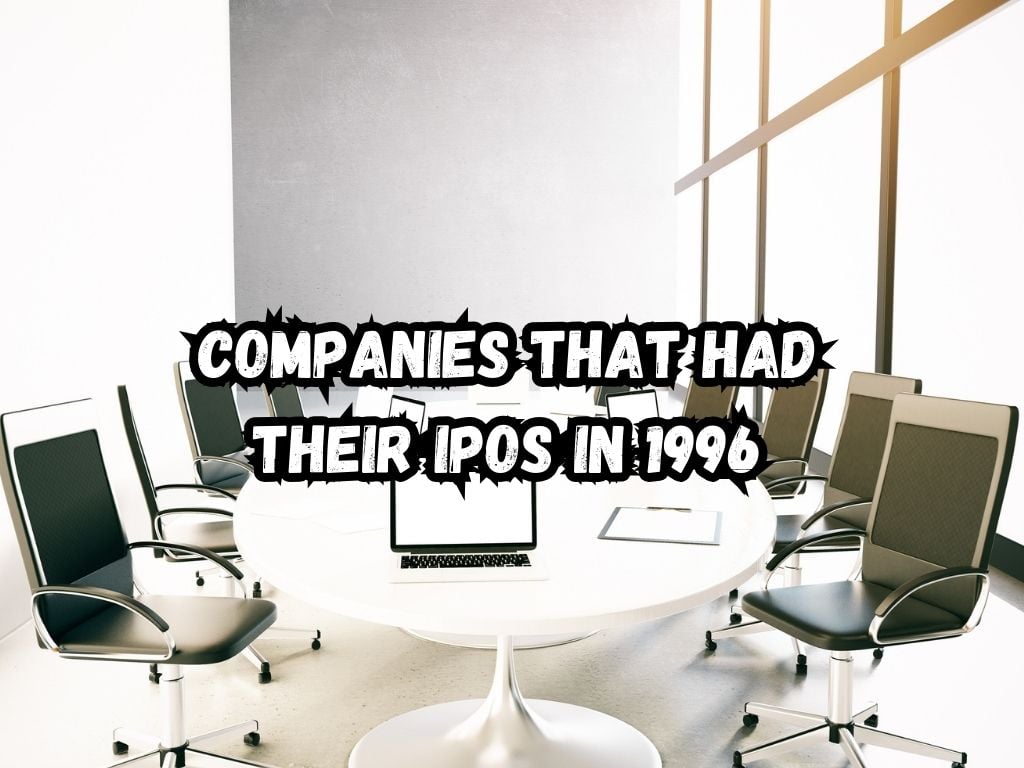In the mid-nineties, a wave of businesses emerged from divergent sectors, eager to capitalize on the expanding avenues of the free market.
The year 1996, in particular, was marked by a series of initial public offerings (IPOs) that would signal the beginnings of some of today’s most influential corporations.
This article unravels the stories of companies that had their IPOs in 1996, their IPOs, and their subsequent journey, providing invaluable insights into one of the most prolific eras in financial history.
Introduction to IPOs in 1996
The financial market in 1996 was a buzzing hive of activity, emboldened by the dot-com boom and a global push toward market liberalization.
In this vibrant atmosphere, companies saw IPOs as an opportunity to harness the energy of global capital markets to fuel their growth and expansion.

Understanding IPO Importance
The Initial Public Offering is the process by which a private company becomes publicly traded by offering its shares to the public for the first time.
By tapping into the wealth of the general market, businesses could access funds beyond their traditional capital raising avenues.
The Financial Climate of 1996
In 1996, the telecommunication and internet sectors began showing their potential, bringing about new modes of commerce and communication.
Amidst this technological renaissance, companies vied to establish themselves as front-runners in their respective industries by pursuing IPOs.
Companies That Had Their IPO in 1996
Acer’s Ascent
Taiwan’s Acer, already recognized for its personal computers, leveraged its IPO to catapult itself into a global brand. The funds raised helped them develop cutting-edge technology and expand their reach worldwide.
eTrade’s Evolution
eTrade seized the moment in 1996 to democratize the often-complicated world of stock trading. Their platform offered an easy-access gateway to investments, appealing to the masses and ushering in a new wave of financial independence.
Hot Topic’s Entrance
Amidst these tech giants, Hot Topic made a move to capitalize on its unique position in retail. The company tapped into the youth culture, making its IPO a strategic move to scale operations and solidify its branding efforts.
A Quarter-Century Later: The Impact of These IPOs
Reflecting on this period, the post-IPO trajectories of these companies offer a rich canvas illustrating the importance of IPOs.
Acer’s Technological Strides
Despite facing fierce competition, Acer has shown resilience and adaptability. Their continued relevance in the tech industry underscores the lasting impact of their well-timed IPO.
eTrade’s Digital Integration
Acquisition by Morgan Stanley notwithstanding, eTrade’s pioneering of online trading platforms has been absorbed into the larger banks’ offerings, illustrating the significance of technological foresight.
Hot Topic’s Cultural Niche
Hot Topic leverages its IPO to become a cultural icon, speaking directly to subcultures and young audiences through its targeted merchandise. The initial public funding was crucial to create this niche market space that continues to thrive.
In Comparative Perspective: IPOs and Progress
Drawing comparisons among the IPOs of 1996, it becomes evident that a company’s future isn’t bound by its initial public valuation alone.
Digital vs. Retail
eTrade and Hot Topic’s growth highlights how various sectors can use IPOs to enhance their impact. Technological adaptation was key for eTrade, while Hot Topic used its public funds to cement its place in the retail landscape.

Reflecting on the IPO Class of 1996
As we look back, the initial offerings of 1996 impart timeless business wisdom.
The Road to Success
Acer shows the power of sustained innovation and technological persistence.
The Digital Influence
eTrade’s journey underlines the transformative power of digital platforms in finance, though it also serves as a cautionary tale about the swiftly changing landscape that can lead to corporate acquisition.
Capturing the zeitgeist
Hot Topic offers a lesson in understanding consumer trends and cultural currents, harnessing its IPO to link brand identity to the collective consciousness of a generation.
Frequently Asked Questions (FAQs)
What is an IPO and why is it important for companies?
An Initial Public Offering is a process whereby a private company offers its shares to the public for the first time, in the form of a public issuance.
This move from a private to public market setting allows a company to raise capital from a broader market instead of relying on a limited number of private investors.
Beyond the financial gain, an IPO can increase a company’s visibility, boost its perceived credibility, and offer a liquidity option to its private investors.
How do you evaluate the success of an IPO?
An IPO’s success can be evaluated by multiple criteria. These include the performance of the stock immediately after trading starts, such as a positive first-day “pop” and the medium to long-term appreciation of the stock’s price.
Other indicators might include the completion of the IPO within the predicted price range, the amount of capital raised, and whether the funds have been used effectively to achieve the company’s growth objectives.
Were there any unique factors in the 1996 market that influenced these IPOs?
1996 was in the midst of a bull market and the start of the dot-com boom. These conditions, marked by the advent of the Internet and expanding globalization, created a favorable environment for IPOs.
Innovative technologies and new business models captured investors’ attention. The optimism surrounding the future of tech-driven companies, in particular, influenced the success of IPOs like eTrade.
How does the performance of these 1996 IPOs compare to the performance of recent IPOs?
Comparing IPO performances across different periods is complex due to variations in market conditions. Not all IPOs achieve long-term success like those in 1996. Success stories like Acer are exceptions rather than the norm.
Some recent IPOs have also seen substantial growth, like Airbnb and DoorDash, while others have struggled post-IPO, like Uber and WeWork. This underlines the importance of company-specific factors, alongside market conditions, in determining IPO success.
What should investors learn from the 1996 IPOs?
Investors could glean several lessons from the 1996 IPOs. One lesson is the importance of a company’s long-term strategy and its ability to adapt and innovate after the IPO.
Another lesson is the role of market conditions coupled with technological advancements and changing consumer behaviors; these elements can significantly influence an IPO’s success.
Lastly, 1996’s IPOs underline the potential of companies that can leverage IPO proceeds to accelerate their growth, reinforcing the importance of evaluating management’s plans for the use of the funds raised.
Conclusion:
The IPOs of 1996 have left a profound legacy. They serve as case studies for how strategic public offerings can prove pivotal in a company’s growth narrative.
These businesses are testament to how an IPO can be more than a fundraising event—it can be an instrument of transformation that carries a company into new market territories and scales heights previously unimagined.
In the grand architecture of economic history, the IPOs in 1996 are pillars that show us how vision, innovation, and an understanding of market dynamics can combine to create enterprises that endure and evolve across decades.


 Tags:
Tags:










